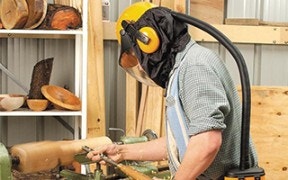Use Respirators to Protect from Sawdust in the Workshop

A powered respirator unit keeps your lungs clear of debris as well as protecting your face. Even if you have a great dust collection system, there are times you’ll need to wear respiratory protection; for example, when running a big belt sander across a panel or sawing up MDF on a table saw, both operations notorious for producing clouds of lung-choking fine dust. But to get the best protection, you must wear the right mask.
If you prefer a disposable, make sure it has two straps and is rated for N95 filtration (the NIOSH standard). Don't cheap out and buy single-strap masks; these are NOT designed to protect you from fine wood dust. Make sure to carefully bend the mask's nose tab so that it fits tightly around your schnoz, and change to a fresh mask whenever the mask gets dirty. If wearing a dust mask fogs up your eyeglasses or protective goggles, switch to a disposable (or half-mask respirator) with a built-in exhaust valve. The valve's flap allows moist air to escape easily out the bottom of the mask, thus preventing eyewear fogging. Cloth-style face masks, like the "Dust Bee Gone," are lightweight and offer little air resistance, which adds to user comfort and helps prevent fogging.Washable and reusable, they're also a "greener" alternative to disposable masks.
Step-Up Solution: Powered Respirators
If you have a beard or other facial hair, a regular disposable mask or half-mask respirator won't seal properly around your face, allowing fine dust to creep in. For better protection, switch to a powered air-purifying respirator (PAPR). Devices such as the Trend Air Shield and Triton air helmet enclose your entire face or head in a protective bubble that's supplied with clean, filtered air blown in by a small battery-powered fan. PAPRs are particularly great if you’re plagued with allergies and respiratory problems and/or want maximum protection from exotic wood dust and toxic dusts from sanded finishes, glues, etc.
Keep the inspiration coming!
Subscribe to our newsletter for more woodworking tips and tricks


